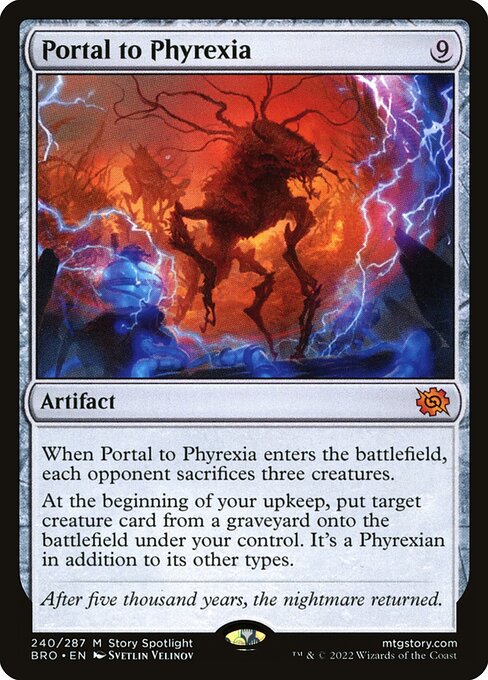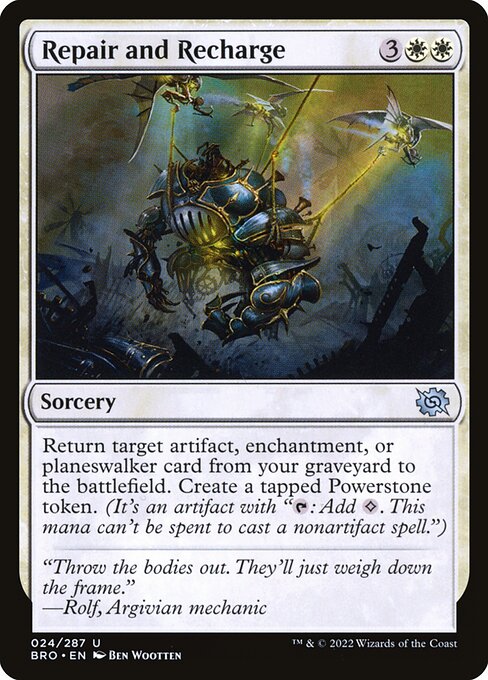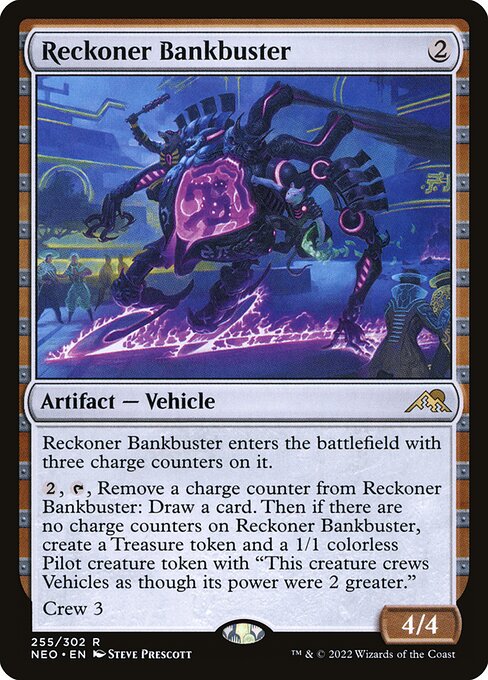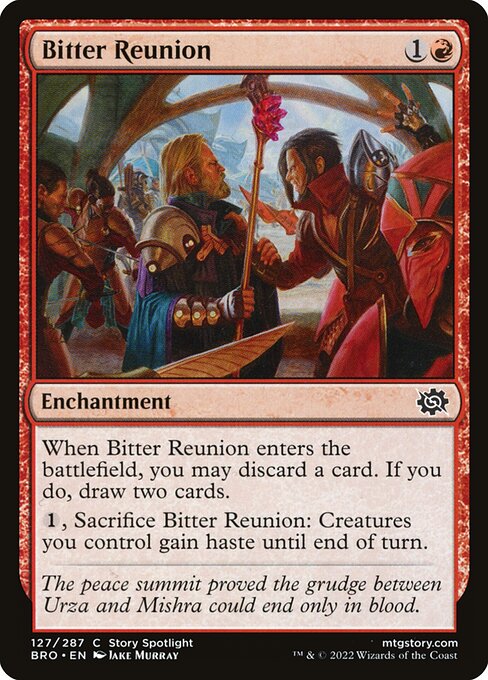Table of Contents
Some time back, I talked about Rakdos Reanimator as a way to maintain the interactive axis but go over the top compared to other midrange decks. The deck still has success but admittedly has to be able to play through cards like Unlicensed Hearse post board. In that deck, Atraxa, Grand Unifier was castable but it would have to come very late in the game. It got me thinking whether it’s possible to circumvent the downside of being prone to graveyard hate and…yes, it is. If your payoffs are big, colorless threats, you only need The Mightstone and Weakstonein your deck to suddenly make them castable on a regular basis.
This deck is an interactive strategy with a ton of card selection whose goal is to put Cityscape Leveler or Portal to Phyrexia into play, be it by reanimating them or straight-up casting them. There will be turn four nut draws where Portal gets cheated into play and steals the game, but against most disruptive decks, we’re going to reach a stage where we will keep casting those game-ending threats turn after turn. This brew has arguably been the most successful of the ones I’ve recently done, as it maintained a 60%-ish win ratio in over 50 games.
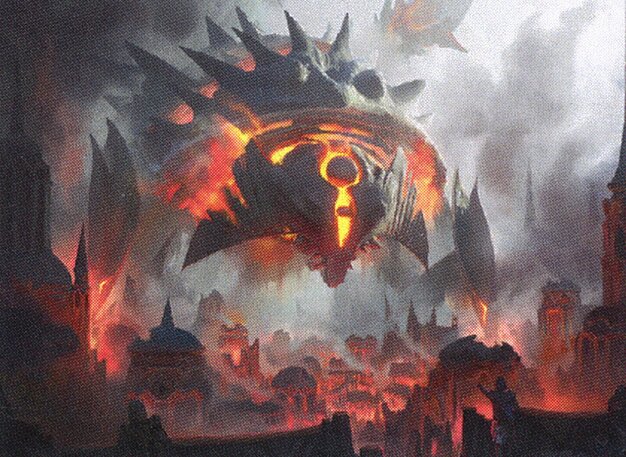

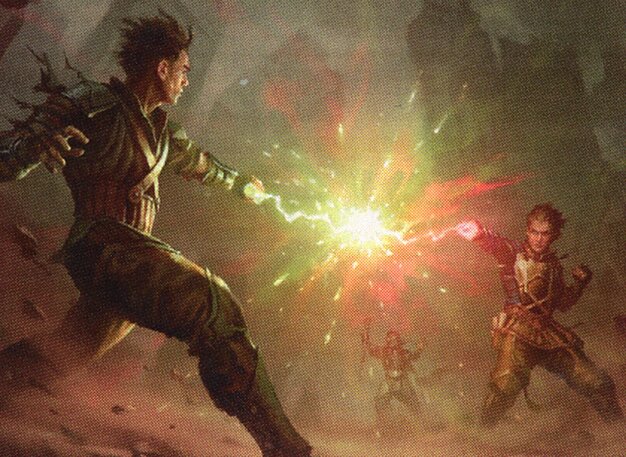
Creatures (3)
Artifacts (12)
Lands (25)
60 Cards
$387.32
Sideboard
15 Cards
$134.87
If you want to see the deck in practice, check out my latest video on YouTube! There are even more Standard videos there, so make sure to visit the channel.
Deck Tech
Top End
The best artifact payoff in the format. Portal to Phyrexia offers triple removal when played which might be enough on its own. It’s particularly strong against black-based strategies that now lose their Graveyard Trespasser, Sheoldred, the Apocalypse, and Tenacious Underdog Overall, such an effect is strong against 3-5 mana creatures, as the opponent is going to lose a ton of mana invested into them.
The other effect is reanimating a creature every single turn. This deck does not play many creatures itself so you’re usually going to be looking at the opponent’s side of the battlefield. You don’t have to bring back a haymaker to make this effect worthwhile. After all, you’ve just Wrath of God-ed the opponent. Even if you bring back Bloodtithe Harvester, they have to deal with it. And when they do, you’ll bring it back…rinse repeat.
There is some counter play to Portal, most notably Abrade and incidental graveyard hate like Graveyard Trespasser. Thankfully, these effects don’t do anything against the sacrifice ability, so you’re always getting the mass removal. It makes a huge difference since the opponent is going to lose a ton of resources anyways, and on top of that, you’re demanding an answer to reanimation. If the opponent eats their own creatures every time, that’s fine. You keep playing your game, threatening to flip the script. Importantly, if you make them sacrifice creatures, it immediately fills up the graveyard, so they need to play a Trespasser or Dennick, Pious Apprentice on the following turn and they need to have sacrificed only a single creature for that Trespasser to negate reanimation. Clearly, there is a lot going on but it makes the games that much more intricate and interesting.
The only creature in the deck. Cityscape Leveler is surprisingly resilient, considering the removal that’s played in the format. Most importantly, it cannot get killed with Go for the Throat in the late game, which is crucial against all the Bxx decks.
It being an 8/8 trampler usually gets the job done. Regardless of whether it’s played or reanimated, its sheer size dominates the whole battlefield and usually closes the game in two attacks. No creature in the format out-sizes it.
On top of that, it has a cast trigger that removes any nonland. It is very much relevant, as it can invalidate the best thing the opponent has done and that could be a planeswalker, Sheoldred, the Apocalypse, or maybe Mechanized Warfare. It both puts you ahead and sets the opponent back. If the opponent does have a piece of removal that lines up well against Leveler such as Abrade, you still got some value out of it by getting a Vindicate.
I have had situations when my Leveler would get cleanly answered with Ossification or Leyline Binding, not even allowing me the unearth ability. While it’s not a good spot to be in, it’s essentially a ticking time bomb, as any subsequent Leveler will destroy that enchantment and free the other one.
Unearth comes up mainly in games where you discard it early, don’t draw reanimation, and just go up to 8 mana naturally. However, I try to hold it off until the attack is lethal or the attack trigger kills something relevant. Spending eight mana to decrease the opponent’s life total from 17 to 9 isn’t worthwhile.
All in all, it does a lot for the deck. It’s our catch-all answer and a resilient threat, all in one.
When you see a reanimation spell in white, you’re thinking Invoke Justice. Why do I play Repair and Recharge? There are a few reasons.
First, the Powerstone you get from Repair is more relevant than the counters. It further allows you to ramp for when they answer your reanimated threat. On top of that, if you reanimate Portal to Phyrexia, you wouldn’t have anything to put counters onto anyways.
On top of that, this deck is predominantly red and maindeck white is only needed for reanimation. It’s easier to pull off a card with WW in the cost rather than WWWW.
Now let me present a powerful nut draw that this deck can muster. If you play a turn three Fable of the Mirror-Breaker, you’ll get a token. On turn four, you use the second chapter of the saga to discard a reanimation target. You attack with Shaman to get a Treasure and play a land drop. Now you have five mana total (4 lands and a Treasure), so you can cast Repair and Recharge. Turn four reanimation!
Having played a few dozen games with this deck, I honestly could see it drop reanimation altogether but it’s a nice way to have the nut draw from time to time.
The sleeper best card in the deck. The Mightstone and Weakstone overperformed hard. The first thing that needs to be said is that it complements the curve very well. A turn-five Weakstone allows you to play Cityscape Leveler on turn six – six lands and two mana from the Stone. It’s a very smooth way to get into the mode of hardcasting big threats. In addition, the two mana it generates can be used the turn you play it to activate or play Reckoner Bankbuster.
The enter-the-battlefield trigger is nothing to scoff at either. We choose between Divination and Dismember and the choice does matter a lot. If you know that you will dominate the end game and your hand does work fine if given a few more turns, choose the removal mode to ensure that you do stay alive. Crucially, it kills Sheoldred, the Apocalypse, Serra Paragon, and all the 1-3 drops in the format.
The fact that there is a draw mode alleviates the downside of it being legendary. You can always float mana with your Stone, and play another one, essentially for three mana, and draw two more cards.
This is literally the perfect card for a ramp deck between the ramp itself and the modality of card draw and removal.
Interaction
Contrary to ramp decks in other formats, it is not as linear. Even discounting Leveler and Portal as interaction, there are eight more copies of removal whose goal is to help us stay alive.
Strangle is our one-mana removal of choice. In short, this piece of removal deals the most damage for the least mana. I want to make sure that I can kill any one or two drop, and even some three drops. Creatures that have 3 toughness include cards such as Corpse Appraiser, Dennick, Pious Apprentice, Graveyard Trespasser, or Gix, Yawgmoth Praetor.
Quad mass removal is a great way to stay in the game. It’s a game-changer against decks like Selesnya Toxic or Mono Red, but it has applications against other decks. You will face curves such as turn two Tenacious Underdogand a turn three Corpse Appraiser or Graveyard Trespasser. The mode that destroys artifacts isn’t nearly as useful as killing creatures.
It’s never really bad to draw too many pieces of removal, as you can always discard them to our card selection spells, mentioned below.
Card Draw and Card Selection
As with all reanimator decks, you need to be able to discard your payoffs to later bring them back. This deck has both pure card advantage but also discard outlets.
Reckoner Bankbuster is a well-known, wildly played card advantage engine. In this deck, deploying it on turn two sets you back a bit but you can immediately get back into the game thanks to Brotherhood's End. On top of that, the Treasure token you get having depleted its counters does come up, as you want to ramp up to nine mana.
In addition, it’s a great mana sink for when you don’t have big threats to play but you have mana available to be sent.
Bitter Reunion is surprisingly strong in this deck. First, it allows you to discard Portal or Leveler early to have it ready for future reanimation. You then draw two so it smooths out your draw and ensures you hit all the land drops. Even without a big threat in hand, it’s a good card to just filter through the cards.
On top of that, the ability to give haste puts this deck over the top. You can give haste to your just-cast Cityscape Leveler to attack for eight and have another attack trigger or to the creature you’ve just reanimated with Portal to Phyrexia. I’ve had multiple games where I’d bring back opposing Graveyard Trespasser, relieve it off summoning sickness, and go to combat on the same turn. Sometimes it might even be better to play your big spell a turn later to ensure that you can give it haste and potentially close the game in one turn.
While it’s arguably the strongest card in Standard, it has some unique applications for this shell specifically. As I’ve already mentioned, it enables reanimation as early as turn four. Card filtration offered by the second chapter does not only have to filter through the reanimation spells. Ditching redundant lands or dead removal also comes up. The cherry on top though is Reflection of Kiki-Jiki that can copy the opposing creatures we bring back with Portal to Phyrexia. If that wasn’t enough, you can copy Cityscape Leveler! It’s *very* difficult to defend against two 8/8 tramplers that kill everything on their way.
Best of One



Creatures (3)
Artifacts (12)
Lands (25)
60 Cards
$361.1
The version of Best of One is aligned with the main deck of the Best of Three version.
Budget
The whole idea behind the deck is to play good cards, ramp, and play or reanimate payoffs. Unfortunately, the ramp, the payoffs, and the generically good cards are all rares or mythics.
Matchups and Sideboard Guide

Grixis Midrange
| IN | OUT |
|---|---|
| +4 The Wandering Emperor | -4 Strangle |
| +3 Squee, Dubious Monarch | -2 Brotherhood's End |
| -1 Bitter Reunion |
Against value decks, I tend not to even lean too much on the reanimation angle and focus on hardcasting threats. The main reason is that I don’t want to get disrupted by cards that are commonly played like Graveyard Trespasser, Corpse Appraiser, or Unlicensed Hearse.
We are, in a way, an aggro deck that has a powerful top-end. Squee, Dubious Monarch demands an answer immediately and alongside Fable of the Mirror-Breaker and The Wandering Emperor our threats demand an answer every turn.
Mono White Midrange
| IN | OUT |
|---|---|
| +4 The Wandering Emperor | -4 Strangle |
| +2 Depopulate | -2 Bitter Reunion |
Similar to Grixis, we want to play an interactive value game. I don’t side in Squee, Dubious Monarch as there are too many pesky creatures that block and I’d much rather lean on Brotherhood's End and Depopulate.
You have to gauge how much graveyard hate your opponent plays and if you see a lot of it, try to lean more onto casting the threats rather than reanimating them.
Esper Legends
| IN | OUT |
|---|---|
| +2 Depopulate | -2 Bitter Reunion |
| +4 The Wandering Emperor | -2 Repair and Recharge |
| -2 Reckoner Bankbuster |
We want to kill everything we see with the ability to slam Portal to Phyrexia. The Mighstone and Weakstone kills Sheoldred, the Apocalypse and Raffine, Scheming Seer. Thankfully, you can pay for ward with Stone’s mana.
You really don’t want to see Thalia, Guardian of Thraben so if you only have Strangle in hand, keep it for Thalia instead of killing Skrelv, Defector Mite.
Selesnya Toxic
| IN | OUT |
|---|---|
| +4 The Wandering Emperor | -4 Reckoner Bankbuster |
| +2 Depopulate | -2 Bitter Reunion |
| +2 Deadly Riposte | -1 Cityscape Leveler |
| -1 Fable of the Mirror-Breaker |
I don’t foresee being interacted with too much as the game is much more about interacting with them. I will happily draw as many Brotherhood’s Ends as possible to just keep cleaning the field. It does progress us as we make land drops along the way. Cityscape Leveler does not shine against a wide board but Portal to Phyrexia does.
Boros Reanimator Ramp Mirror
| IN | OUT |
|---|---|
| +4 The Wandering Emperor | -3 Brotherhood's End |
| +3 Squee, Dubious Monarch | -4 Strangle |
The mirror is a midrange matchup where both players have a combo finish, similarly to Rakdos Reanimator mirror. Ramp is key as it will allow you to start playing your big threats first. Siding in Unlicensed Hearse is interesting because you can just forget about it and focus on enacting your plan more rather than interacting with them. If you are more scared of them doing their thing, you can side in some number of Hearses.
Tips and Tricks

- You don’t have to discard any cards to Bitter Reunion, this comes up when you want to play it as a haste-giver.
- You can give haste with Bitter Reunion to Fable of the Mirror-Breaker‘s Goblin to immediately make mana or to the flipped Reflection of Kiki-Jiki to be able to copy something on the same turn.
- Unearth is not *cast*, so when you play Cityscape Leveler off unearth, it won’t trigger. It will, however, trigger if you get to attack with it.
- If the opponent’s board has been ravaged by your Cityscape Leveler, subsequent triggers can target Powerstone to change the untapped one to a tapped one – but that’s going to matter in a very minor subset of situations.
- You can make Graveyard Trespasser‘s ward trigger beneficial to you by discarding a payoff for later reanimation.
- You might want to Repair and Recharge Bitter Reunion for the haste ability to close the game immediately.
- Against sacrifice effects, always remember you can crew Reckoner Bankbuster with Cityscape Leveler and then sac Bankbuster. It’s relevant against Invoke Despair, Sheoldred's Edict, or Liliana of the Veil.



